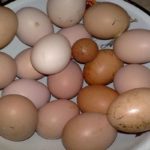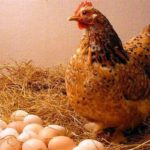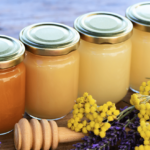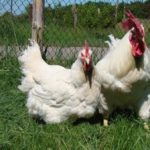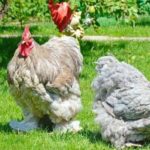Why chicken eggs are white and brown depends on the breed of bird. Regardless of the color of the shell, it is recommended to consume chicken eggs regularly, as they contain all the necessary minerals and substances. This product improves the functioning of internal organs and is consumed both raw and as an addition to dishes.
What color are chicken eggs?
Chicken eggs can be white or brown.You can also find white products with brown splashes. Chicken eggs can also differ not only in the color of the shell, but also the yolk. More often, in white specimens the yolk is light, and in brown specimens it is darker.
Important. Some chicken breeds lay blue eggs. However, such a product is very difficult to find on sale. This type does not differ in taste from the usual product. You can also often find products with a golden shell. The shell may have a slight pink tint.
What determines the color of a chicken's shell?
The color of the shell may depend on factors that need to be taken into account when choosing products.
Breed
Chickens come in different colors. The color of the feathers depends on the breed of bird. This criterion may affect the shade of the shell. It has been noted that birds that have brown colored feathers lay dark colored eggs. You can find a shell with brown spots or streaks. Such specimens do not reduce their taste properties and are used as food.
Laying hens of meat breeds are large in size and often colored red or brown. Such birds produce products with a brown shell.
Ambient conditions
The conditions under which chickens are raised can affect not only the size, but also the color of the shell. More often, incorrect conditions and cramped spaces contribute to the fact that the shell does not produce enough protoporphyrin, the pigment that is responsible for the color of the shell. As a result, the eggs turn white or have a slight yellow tint.
The color of eggshells is affected by the chickens' diet. Birds that eat little greens and natural grain foods carry products that have a pale shell color. Also, the color of the shell can be affected by the period when the bird walks in sunlight.
Birds that regularly walk outdoors also lay brown eggs.
What does the color of the yolk say?
The color of the yolk may vary depending on the bird's diet. Chickens that regularly eat natural food and fresh herbs lay eggs whose yolk is rich in color. Birds that live in cramped conditions and eat special feed lack vitamins, so the yolk has a light shade.
Also, the presence of diseases in laying hens can affect the color of the yolk. Laying hens that are sick may produce products with pale yolks.
What color eggs taste better?
The question of which egg tastes better is difficult to answer. The products have the same nutritional value regardless of the color of the shell. However, when purchasing, you need to pay attention to the labels. There are dietary types and aged (table) types. Such categories are marked with the letters D and C. The first type of product is fresh and can be used for raw consumption.
You also need to consider the type of product: store-bought or homemade. Homemade eggs, regardless of the color of the shell, have a rich taste and contain all the useful substances.
What to feed chickens to get orange yolks?
Chickens eat all grain-based foods, so feeding the birds is easy. However, in order for chickens to be healthy, it is necessary to choose the right type of food. Improper nutrition leads to decreased egg production and pale yolks. Also, the lack of proper food negatively affects the taste of products. In order for chickens to lay eggs with orange yolks, it is necessary to feed the birds the following natural types of food:
- Corn is a natural source of all the vitamins necessary for poultry, which increase egg production and contribute to the orange coloration of the yolk.
- Bran - colors the yolk orange and strengthens the shell.
- Wheat.
- Beans.
- Chalk and shell rock strengthen the shell of the product and help improve taste.
- Greenery. In the summer, it is necessary to stock up on dry hay, which is subsequently steamed and used for feed.
- Cottage cheese.
- Millet.
- Carrots, tomatoes, pumpkin and beets.
Properly prepared mixtures using fresh grass and grain also affect the shade. Forbs have a positive effect on the health of laying hens and product quality. Nettle, alfalfa, yarrow, and beet tops are most often used.
Some manufacturers add special dyes to the diet that color the yolk in the desired shade. Such dyes contain artificial carotenoids, which not only color the yolk, but also the shell.
Why are brown eggs more expensive?
The myth that says brown casing is healthier is not true. More often, the cost depends on the category to which the product belongs. The first, second and third categories are distinguished. The category type is determined based on weight. Chickens with dark feathers are considered meat chickens and carry large eggs. Therefore, such products are more expensive. Some sellers deliberately inflate prices, explaining that such products contain a larger list of useful substances necessary for the human body.
Which eggs are still worth buying?
It is recommended to purchase eggs from a trusted person who raises laying hens on his own.Factory-made eggs are not always fresh, regardless of the markings on the shell.
Homemade products are valuable because natural products are used as food for birds. Regardless of the color of the shell, the products have the same nutritional value.
When purchasing eggs, you should give preference to dietary ones. This product has a shelf life of up to 7 days. The rest go to the canteen section, and can have a shelf life of 10 days. It is also necessary to pay attention to the cleanliness of the shell. The washed product is not stored for more than 5 days. When choosing homemade ones, you should give preference to the natural appearance of the shell, which has not been subjected to a cleaning procedure.
Important. To avoid the risk of poisoning, after purchasing the product, you must use a container of water where the egg is placed.
Fresh ones will sink, but old ones will float; it is not recommended to eat such a product. It is also necessary to examine the condition of the shell, which should be free of cracks and stains that are not typical for healthy products.
Conclusion
When choosing eggs, there is no need to give preference to large ones. Small specimens are carried by young birds. This does not affect the taste of the product. Also, the shade of the shell does not affect the taste. The characteristics of poultry rearing and proper storage of the product are important. The last criterion is often violated if products are purchased in supermarkets.








